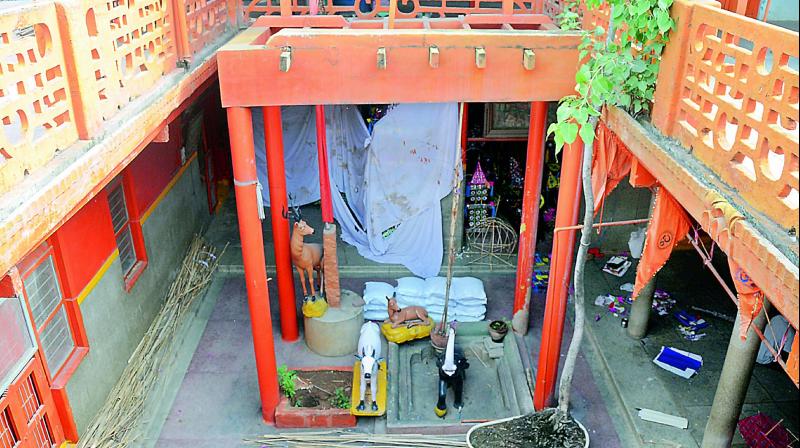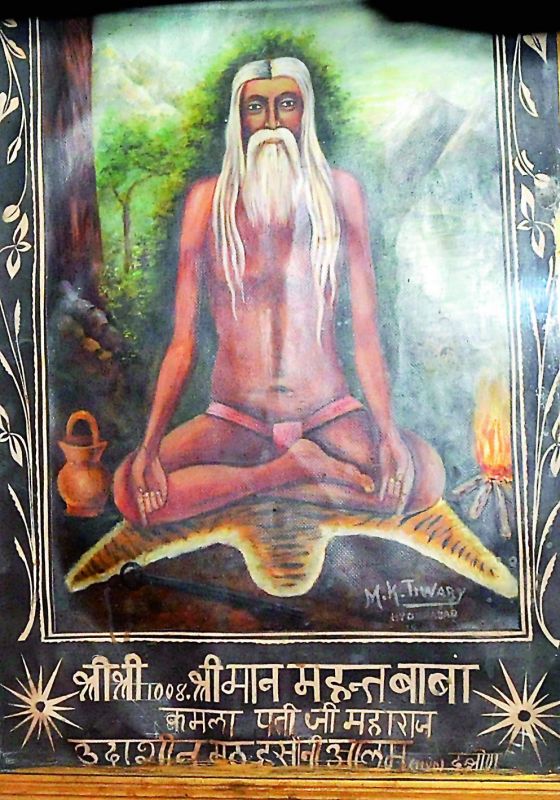Udasin Math loses its majestic looks, not its importance

Hyderabad: Husaini Alam, is now a crowded place, with barely enough road for traffic and a mere breathing space for pedestrians. Shops crowd both sides of the road and in the midst of all this is the Udasin Math, a sect in Sikhism, started by one of the sons of Guru Nanak, the founder of Sikhism. The building stands abutting the Husaini Alam Darwaza which has lost its majestic looks and can be missed in the chaotic traffic. This road earlier used to be the Golkonda-Charminar road and therefore has importance.
All the land that the Math may have owned earlier has disappeared and there are buildings connected seamlessly on one side while the other side has the Hussaini Alam Darwaza. There is a stonewalled entrance to the Math with a designed arch and a big door. There is a first floor and balcony right above the entrance and, probably, the Babas of yesteryears gave their darshan to the devotees from the balcony.
The inside seems crowded and though there is an open-to-the-sky roof, the place looks all shut in. There is a peepul tree growing out of a bathtub painted in bright orange. It reads North Western Pantry, John Leviga, Birmingham. Perhaps, in order to create a feeling of greenery and the looks of a forest, there are animal statues, including that of an elephant and a deer, with a lion guarding the gate.
 Sriman Mahanth Baba
Sriman Mahanth Baba
Earlier, as per the beliefs of the Udasin Math, there was the Panchayati Akhada Bhada Udasin Nirman Akhada abutting the Musi. It is still there and is looked after by another Mahant.
A hall, to the side on the ground floor, has walls filled with black and white pictures which include the later Mahants Sundardasji, Purandasji and Sevadasji with people from the Nizam’s circle and various other important people of the times. Also present are the first President of independent India, Dr Rajendra Prasad, in quite a few photos, Raja Rao of Wanaparthy, President Zail Singh and many other important figures in history. In fact, many of the Samasthanam rajas used to consult the Udasin saints quite regularly. Purandasji is remembered for his attire, a black robe with a black turban, and in the 1920s he was guru to several Samasthanam’s including Cheelam Janki Bai. The famous writer K.M. Munshi says that Maharana Pratap sought Sri Chand’s blessings to fight against Akbar. Jahangir also sent his men along with elephants to bring Sri Chand to his palace at Kadrabad, now Nanakchak in Gurdaspur district. On his refusal, the Mughal emperor himself paid a visit to Baba Sri Chand.
Guru Nanak, the founder of Sikhism and the first of the 10 gurus, did not believe in a life of seclusion and withdrawal from worldly affairs and instead, he believed in the importance of family life and domestic devotion. His elder son, Sri Chand, became an ascetic and Guru Nanak disapproved of it. However, Sri Chand continued his religious pursuits without caring for the disapproval of his father. The other son, Lakhmi Chand, took to a worldly life and his descendants are called the Bedis. As neither of his sons adhered to his religious preaching, Guru Nanak decided to nominate Guru Angad as his disciple-successor in 1539.
Sri Chand was the founder of the Udãsî sect and as the elder son of Guru Nanak, he claimed to be the natural heir to the gurgaddi. Though he was not installed on the gaddi of his father, yet he was recognised as a leader and prophet by the Udãsîs, who refused to acknowledge the official successor of Nanak as their guru.
Forty years after Guru Nanak Dev’s death, Sri Chand laid aside his old enmity towards the successors of Guru Nanak and tried to pacify Guru Ram Das, the fourth successor of Nanak and cordial relations developed between the two. With this step, the ice was broken and congenial relations developed between the Udãsîs and the Sikhs. This was the turning point in the life of Baba Sri Chand, the founder of the Udasi sect.
Thanks to Chandu Lal Sadan (1766 - 1845), popularly known as Maharaja Chandu Lal, who served as the Prime Minister (1833 - 1844) during the reign of Nawab Sikandar Jah of Hyderabad state that the Udasin came to South India along with Sikh forces. Another story says that this sect came with Guru Gobind Singh in 1708 and the Udasins were the custodians of the Nanded Gurudwara and it all seems to be during the same period. There is narrow longitudinal room dedicated to 12 samadhis of mahants. While there were 15 mahants who visited Hyderabad state, the samadhis were built only for those who died here. They have all been laid to rest here and given a samadhi in a room.
Many Hyderabadis travelled there and given below is a quote from a banker:
“I visited the Shrichandra Udasin Updeshak Sabha Free Reading Room and was much delighted to find the managements excellent work under Baba Purandasji Maharaja. All this was worthy of the name of the Udasin Sampraday. Among so many papers of different parts, I was amazed to find newspapers of Southern India too. It contained sufficient matter for the Urdu reading public also.
(Source for all history on Udasin Sect is the research done by Kiranjeet Sandhu, Associate Professor, PG Department of History, DAV College, Jallandhar, and other history books)

